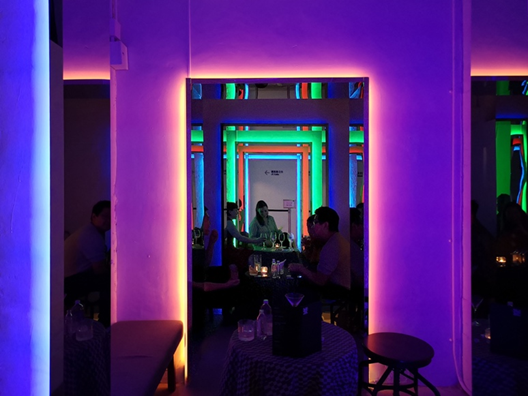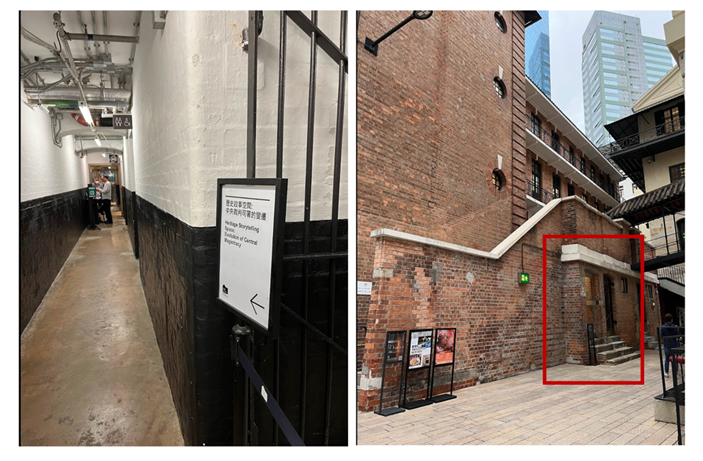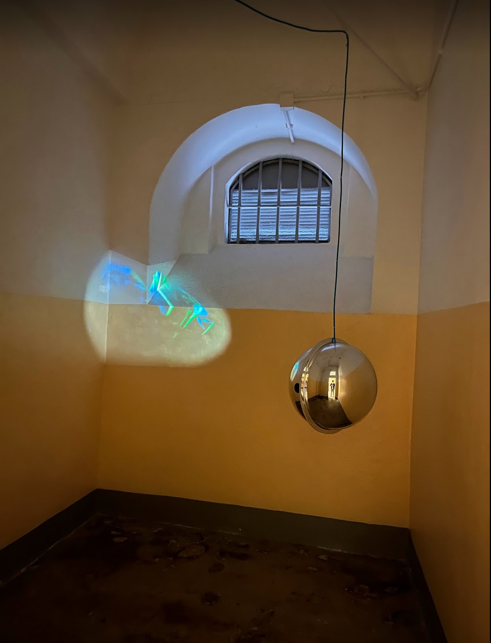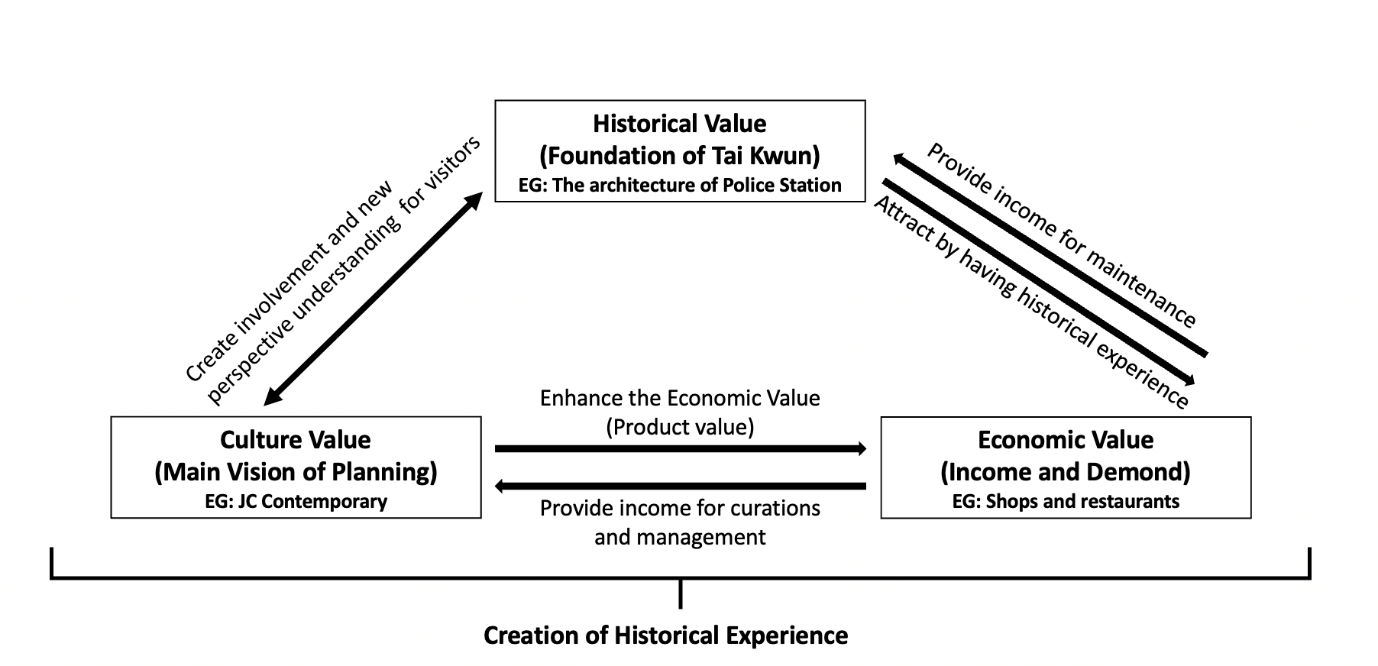Constructions of Historical experience and balance of value
1. Introduction
Hong Kong, a city well-known for its unique historical background of once being Britain’s colony in the past, is left with Western aesthetic complexes after the Handover by the UK government in 1997. The Victoria Prison and Central Police Station was one of them. Now, named as Tai Kwun, same as the historical experience symbolised. Not only did the restoration project reshape the features of the buildings, it also gave a brand new cultural memory for visitors. It exists to be a place remembered as a solemn law enforcement structure by elders and a go-to shopping mall by locals.
This project focuses on how to redefine Tai Kwun while being presented with a cultural geographical perspective of gain understanding of the concepts behind the revitalization of Tai Kwun and the shaping of culture memory.
2. Understand Tai Kwun through Cultural Geographical Perspective
An introductions of Culture Memory
In analysing commercialization of Tai Kwun and its cultural conservation, culture memory is one of the key theory.
Culture memory as a well-form concepts was first proposed by Ben-Amos, D and Weissberg, L, who argue that the culture memory is a key to shape once’s identity (1999). Afterward, Astrid Erll and Ann Rigney carry to revival the values of culture memory and describe culture memory as “an ongoing process of remembrance and forgetting in which individuals and groups continue to reconfigure their relationship to the past and hence reposition themselves in relation to established and emergent memory sites” (Erll & Ann, 2009, p.2).
Culture memory in Tai Kwun
To create new memory for Tai Kwun, combination of past and present, commerce and culture is of great significance. Although Tai Kwun now is completely differentiated from the past, the two are never parted. A comprehensive impression, or culture memory for individuals and groups can only be generated by combination of them.
This essay especially impose the framework which state as “cultural memory come from public spaces and canon-building” (Erll & Ann, 2009, p.2). And find out the canon (like mixture of value and fragmentation) behind the public space (Tai Kwan) producing culture memory.
3. Empirical Analysis
Fragmentation and Unification behind the name: Process of creating new culture memory in Tai Kwun
Much research emphasizes the commercialization of conservating Tai Kwun. Still, some even depict the project as “government playing into the hands of the business sector” (Ku, A. S.-m, 2010, p.397) due to its non-profit status. Nevertheless, more practically, how has this conservation case shaped a new cultural memory of Hong Kong Heritage? This problem helps us reflect on the phenomena of one hand, the scholars and social critics of commercialization. Still, on the one hand, it is one of the most popular sites attracting more than 7.3 million visitors from May 2018 to late 2021 (legislative council, 2021, p.1).
Thus, the creation of new memory takes place through the fragmentation of historical memories and the unifying of the new memories by commercial and cultural elements; these factors explain a part of representations of spaces which is the culture management of Tai Kwan. Officially, the site is named Central Police station Compound, and Tai Kwan is a “colloquial name for local to refer…the whole compound” (Tai Kwan Heritage department, p.2). The names emphasize the group value of Tai Kwun. However, the significant means of promotion——exhibition is fragmentized into different geographical locations without demonstrating the historical connections of three key areas: Magistrate’s House, Victoria Gaol and Police Headquarters. Additionally, the new constructions, such as The Jockey Club Contemporary, an art museum and extra buildings beside the original site, have faintness the boundaries of three historical faculties and reshape the value of historical geography.
Moreover, the stores and restaurants are located in different buildings and take place in more than half of the venues (Ku, A. S.-m, 2010, p.398). The commercialized spaces are furnished fully against their original use, and most of the room dividers are reconstructed to cause the loss of architectural merit. Those changes unified the space using and degree the significance of each key area. Therefore, the cultural memories formed by representational space and spatial practices are transformed, which creates a new “historical experience”.

Figure 1: Who can guess this bar is in Prison Yard, Block E of Tai Kwun? (Source: Parkes, 2018)
Reconnect with Tai Kwun in Mixture value
In a more specific context, revitalizing Tai Kwun is reconnecting the Compound with society. In this sense, the construction of cultural memories with the visitors will be a mission, and still, demonstrating the history of Tai Kwun is transformed to mix with other elements, such as modern art. Indeed, the “storytelling” type of historical presentation is marginalized. Take the permanent exhibitions——Heritage storage places as an example; this exhibition was located in different buildings introducing the stores of that particular area (see Figure 2), such as “The Story of Central Police Station”. Geographically, most sites are located far from the prime locations, such as the underground floor or at a remote location (see Figure 3.) Moreover, according to the leaflet by Tai Kwun, besides the exhibition and interpretation board, other activities promoting the history of Tai Kwun, such as tours and Workshops, are required for registration or applications. Historically speaking and presentations have taken place by cultural activities and commercial use.

Figure 2: Locations of “Heritage Storytelling Spaces” Exhibitions (Source: Tai Kwun)

Figure 3: One of the locations of the exhibitions, the red box indicates the gate of it (Photo by Ho Hay Long)
Rather than unidirectional knowledge communication, the mixed-value project is replaced. Those mixed-value projects including demonstrating arts in particular historical sites, such as the nearest exhibition——“Behind Your Eyelid—Pipilotti Rist”, the spirit of artworks not only physically set up at the heritage but carrying the context with a contemporary art presentation method: moving image installations. One of the artworks named “sleeping Pollen” (see Figure 4), the artwork introduces “the sphere…turn the silvery orbs into “dreams spinning slowly in the air”… the artist imagines the isolations prisoners and loneliness they may face.” (Tai Kwun, 2022) [i]
Those cultural traces reflecting the mixed values are planned as a mainstream of presenting the historical value of Tai Kwun, those mixed-value creating spaces for visitors to explore Tai Kwun through a new cultural experience, which is not a “museum” nor a pure heritage site, but definite by the visitors within the framework. In fact, mixed values as a core value of Tai Kwun; it allows to involve the “revitalization” of the heritage through cultural activities, dining or shopping, and the construction of a representation of Tai Kwun, such as a heritage art museum.

Figure 4: The artwork “sleeping Pollen” (Photo by Ho Hay Long)
Behind the process: Concisely understanding the value management of Tai Kwun
After examining different cases and management in Tai Kwun, can we conclude with a framework in order to understand the reason behind the new cultural memory? According to a concise introduction of Tai Kwun, they proclaim the vision is “offer the best heritage and arts experiences, and to cultivate knowledge and appreciation of… art” (Tai Kwun, 2022)
Besides, the economic value and elements have taken a premier palace, which we have discussed before. These three principal values contribute to “reconfigure their relationship into past and hence reposition themselves in relation to established and emergent memory site” (Erll & Ann, 2009, p.2), which is necessary to construct culture memory, especially through the transformation of boundaries of three main areas and the demonstrations of mixture value.
Thus, the balancing of three values (see figure 5) led Tai Kwun to create an “individual memory…moulded by the specifically social framework in which it operates” and provide a new “stable point of reference for individual and communities a share past” (Erll & Ann, 2009, p.1-2) which can take examples of shopping and arts experiences to reconnect the memories of Tai Kwun and the visitors in a “heritage interaction”.

Figure 5: The figure presents the relations of three main value of Tai Kwun and the creations of new historical experience.
4. Conclusion
After the revitalization, Tai Kwun has been functioning by cultural, historical and economic values instead of solely historical values. While the historical background of Tai Kwun is of less importance to local residents, the compound is creating a new culture memory in hearts and souls of local society.
In normal circumstances, when the visitors aim to shopping or dining out in Tai Kwun, the realizations was more involved by the visitors. It is worth noting that the historical traces of the compound still remain after revitalization for exhibition purposes. Acting as both art centre and leisure destination, Tai Kwun is bound to generate more and more memories and leads new direction of Hong Kong heritage conservation.
Reference
Ben-Amos, D., & Weissberg, L. (1999). Cultural memory and the construction of identity. Wayne State University Press.
Erll, A., & Rigney, A. (2009). Mediation, remediation, and the dynamics of cultural memory. Walter de Gruyter.
Ku, A. S.-m. (2010). Making Heritage in Hong Kong: A Case Study of the Central Police Station Compound. The China quarterly (London), 202(202), 381-399.
Legislative Council (2021), Report on the implementation progress of heritage conservation initiatives ( CB(1)855/20-21(06)) Appendix C.
Parkes, D. (2018). Behind Bars: This Tai Kwun bar nails the atmosphere but could do better with its premade cocktails. Time out. https://www.timeout.com/hong-kong/bars-and-pubs/behind-bars
(n.d.). Exhibitions & Programmes-Heritage Storytelling Spaces. Tai Kwun. https://www.taikwun.hk/en/programme/detail/heritage-storytelling-spaces/33
(n.d.). Our Story: Vision. Tai Kwun. https://www.taikwun.hk/en/taikwun/story.
[i] This is a reference from the board (Photo)


